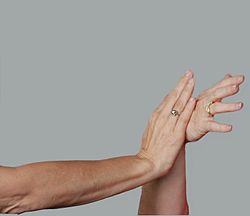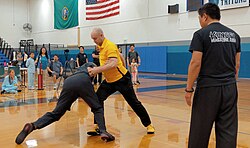Pushing hands
This article needs additional citations for verification. (April 2012) |
| Tuishou | ||
|---|---|---|
Hanyu Pinyin tuī shǒu | | |
| Wade–Giles | t'ui1 shou3 | |
| Yue: Cantonese | ||
| Jyutping | teoi1 sau2 | |
Pushing hands, Push hands or tuishou (alternately spelled tuei shou or tuei sho) is a two-person training routine practiced in internal Chinese martial arts such as baguazhang, xingyiquan, tai chi, and yiquan. It is also played as an international sport akin to judo, sumo and wrestling, such as in Taiwan, where the biannual Tai Chi World Cup is held.[1]
Overview
Pushing hands is said to be the gateway for students to experientially understand the aspects of the
History
According to the Chen family of tai chi teachers, pushing hands was created by Chen Wangting (1600–1680), the founder of the Chen-style tai chi, and was originally known as hitting hands (da shou) or crossing hands (ke shou). Chen was said to have devised pushing hands methods for both empty hands and when armed with a spear. Other tai chi schools attribute the invention of pushing hands to mythical Zhang Sanfeng.
Training pushing hands
In tai chi, pushing hands is used to acquaint students with the principles of what are known as the "Eight Gates and Five Steps," eight different leverage applications in the arms accompanied by footwork in a range of motion, intended to allow students to defend themselves calmly and competently if attacked. Also known as the "13 original movements of tai chi", a posture expressing each one of these aspects is found in all tai chi styles. Training and pushing hands competitions generally involve contact but no strikes.

The three primary principles of movement cultivated by push hands practice are:[2]
- Rooting - Stability of stance, a highly trained sense of balance in the face of force.
- Yielding - The ability to flow with incoming force from any angle. The practitioner moves with the attacker's force fluidly without compromising their own balance.
- Release of Power (Fa Jing) - The application of power to an opponent. Even while applying force in push hands one maintains the principles of Yielding and Rooting at all times.
The Eight Gates (Chinese: 八門; pinyin: bā mén):
- P'eng (centre of gravity, often translated as "Ward Off." Peng is also described more subtly as an energetic quality that should be present in every taiji movement as a part of the concept of "song" (鬆) -- or relaxation -- providing alertness, the strength to maintain structure when pressed, and absence of muscular tension in the body.
- Lü (Chinese: 捋; pinyin: lǚ) - A sideways, circular yielding movement, often translated as "Roll Back."
- Chi (simplified Chinese: 挤; traditional Chinese: 擠; pinyin: jǐ) - A pressing or squeezing offset in a direction away from the body, usually done with the back of the hand or outside edge of the forearm. Chi is often translated as "Press."
- An (Chinese: 按; pinyin: àn) - To offset with the hand, usually a slight lift up with the fingers then a push down with the palm, which can appear as a strike if done quickly. Often translated as "Push."
- Tsai (Chinese: 採; pinyin: cǎi) - To pluck or pick downwards with the hand, especially with the fingertips or palm. The word tsai is part of the compound that means to gather, collect or pluck a tea leaf from a branch (採茶, cǎi chá). Often translated "Pluck" or "Grasp."
- Lieh (Chinese: 挒; pinyin: liè) - Lieh means to separate, to twist or to offset with a spiral motion, often while making immobile another part of the body (such as a hand or leg) to split an opponent's body thereby destroying posture and balance. Lieh is often translated as "Split."
- Chou (Chinese: 肘; pinyin: zhǒu) - To strike or push with the elbow. Usually translated as "Elbow Strike" or "Elbow Stroke" or just plain "Elbow."
- K'ao (Shoulder Strike," "Shoulder Stroke" or "Shoulder."

The Five Steps (Chinese: 五步; pinyin: wǔ bù):
- Chin Pu (Chinese: 進步; pinyin: jìn bù) - Forward step.
- T'ui Pu (Chinese: 退步; pinyin: tùi bù) - Backward step.
- Tsuo Ku (simplified Chinese: 左顾; traditional Chinese: 左顧; pinyin: zǔo gù) - Left step.
- You P'an (Chinese: 右盼; pinyin: yòu pàn) - Right step.
- Chung Ting (middle way" as discouraging extremes of behavior, or in this case, movement. An extreme of movement, usually characterized as leaning to one side or the other, destroys a practitioner's balance and enables defeat.
The Eight Gates are said to be associated with the eight

Pushing hands
Competition

Pushing hands has become a part of competitive Chinese martial arts, especially those devoted to internal arts. The rules and the judging are subjective, problematic, and constantly in flux.[3]
Push hand contests is divided into two types.
- Moving step (Chinese: 活步; pinyin: huó bù) - The players stand in a circle; the player who is pushed or pulled out of the circle, or falls down, loses a point.
- Fixed step (Chinese: 定步; pinyin: dìng bù) - The players stand in a small box; the player who is pushed or pulled out of the box loses a point.
See also
- Chi Sao
- Ching
- Dantian
- Neijia
- Silk reeling
- Taijitu
- Tao Te Ching
- Wudangshan
References
- ^ "World Tai Chi Federation". World Tai Chi Federation. World Tai Chi Federation. Retrieved 31 January 2016.
- ^ Patterson, Jeff. "Understanding Tai Chi Push Hands". nwfighting.com. Northwest Fighting Arts. Archived from the original on July 6, 2017. Retrieved 12 March 2014.
- ^ Michael R. Pekor. "The Nature of Push Hands Competition in America". patiencetaichi.com. Archived from the original on March 8, 2007. Retrieved December 28, 2019.
External links
- Tai Chi Classics A translation of the Tai Chi Classics, which deal with the application of Eight Gates
- Pushing Hands Quotes
